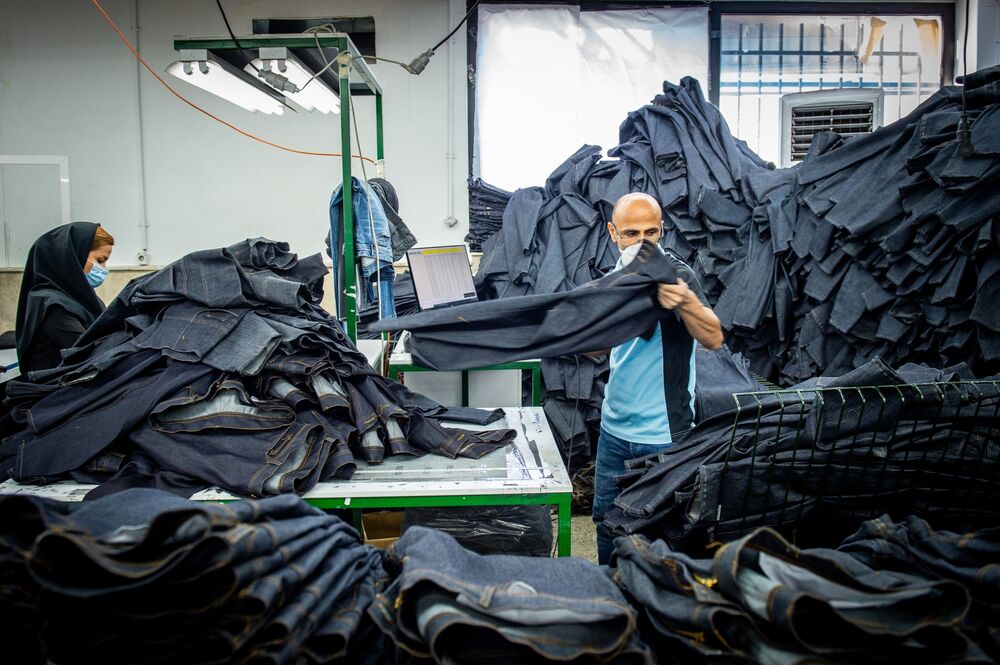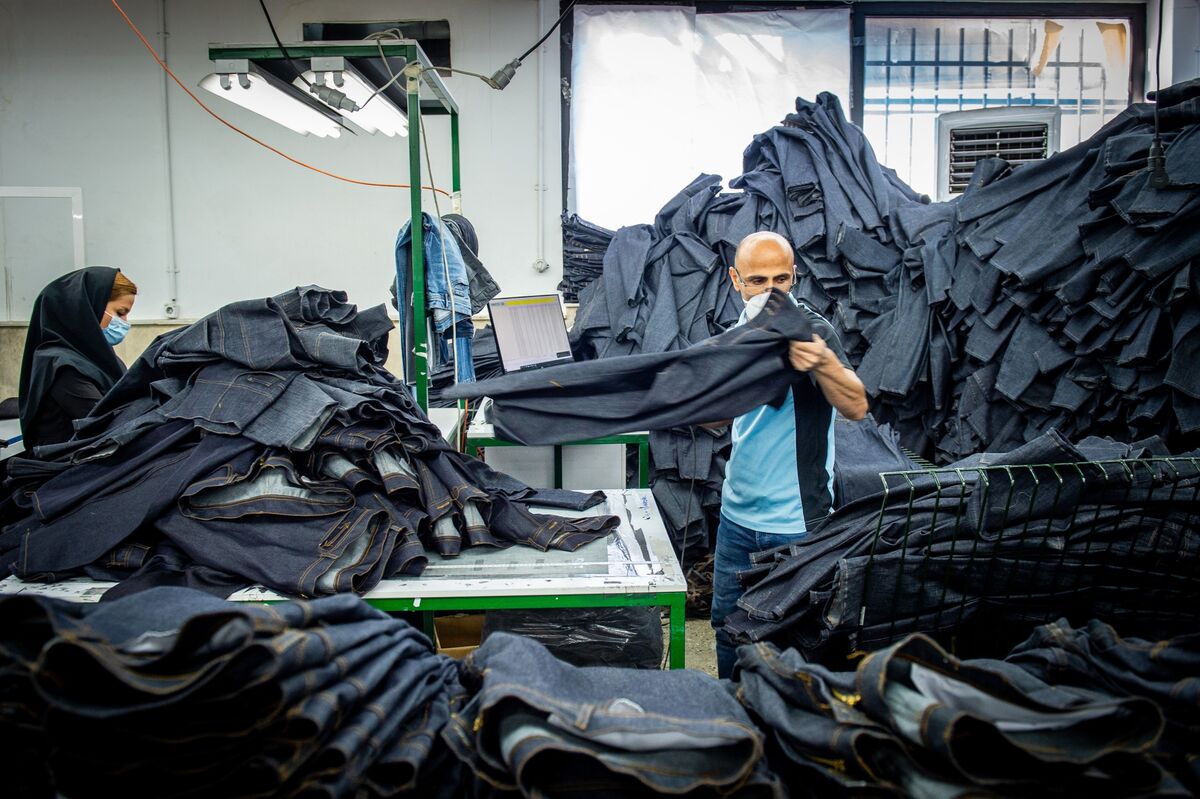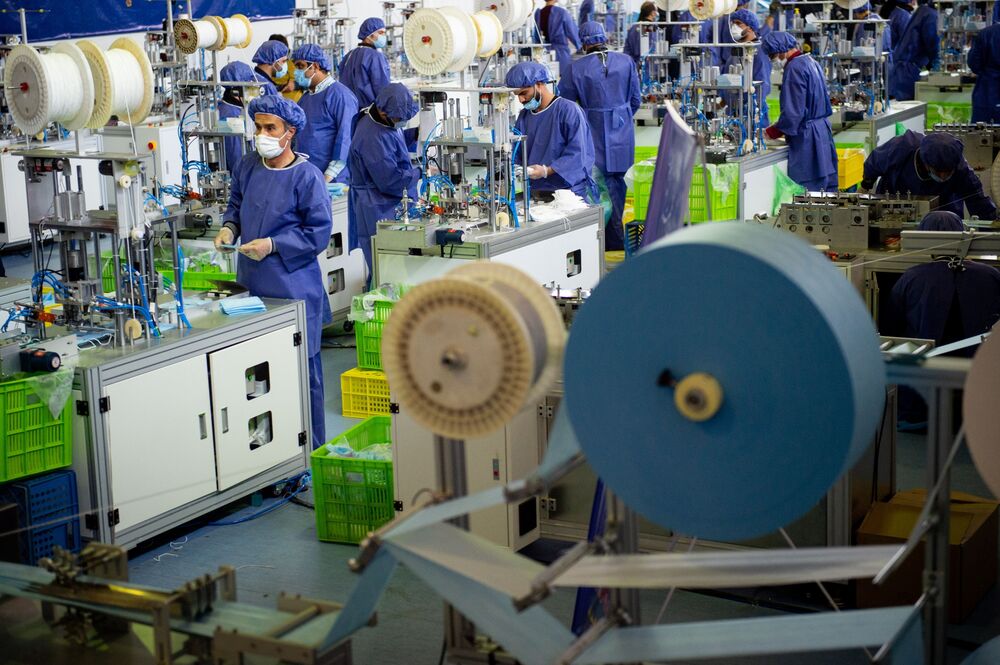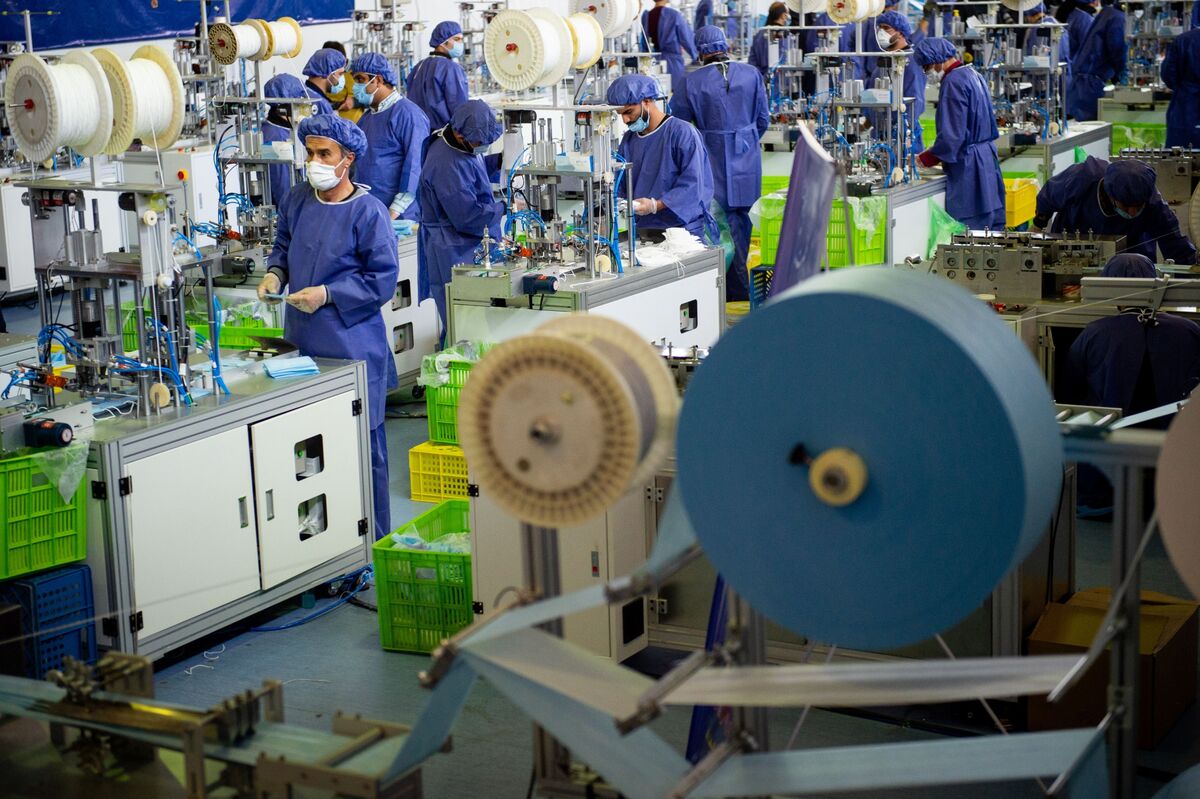SalarHaqq
SENIOR MEMBER

- Joined
- Dec 29, 2019
- Messages
- 4,569
- Reaction score
- 2
- Country
- Location
‘Made in Iran’ Thrives in Economy Trump Tried to Crush
Small companies are filling the vacuum for consumer goods as Iranians struggle to buy foreign brands.
By Golnar Motevalli
18 October 2020, 06:00 CEST

Workers assemble jeans at a clothing factory in the outskirts of Tehran on Oct. 14.. Photographer: Ali Mohammadi/Bloomberg
There can’t have been many worse times to start a new business in Iran. Even before officials in the Islamic Republic alerted the public to a major outbreak of the coronavirus, the country started the year in a tense standoff with the U.S. while its economy was being crippled by sanctions.
For a trio of design graduates, a captive market of tens of millions of consumers starved of imports made it worth the risk. Their fashion brand, Koi, has sold thousands of crop tops and striped jeans since July.

The Koi design team at their studio on the outskirts of Tehran, including co-founders Armita Ghasabi, Fojan Fard and Yasaman Ghanbari and data analyst Soheil Zhalepour. Photographer: Ali Mohammadi/Bloomberg
“Made in Iran” has emerged as a rare glimmer of hope in the financial destruction from being ostracized from the oil market and global trade while Covid-19 rages. In a country where so many people’s lives have been defined by cycles of Western restrictions, brands like Koi, Zi Shampoo and Bonmano Coffee are among the homespun names that are filling the vacuum for consumer goods.
“We just knew it would work because we ourselves and so many people around us were so desperate for basic, simple things,” said Armita Ghasabi, 30, one of Koi’s founders.
Koi uses fabric spun at a textile mill in Iran’s northwestern city of Khoy, eliminating the need for imported materials. A dearth of competition from global brands and low labor costs keep prices affordable and their margins healthy, according to Ghasabi. For every $18 pair of jeans, they make the local currency equivalent of $11 of profit to spend on new product lines.

Koi uses fabric spun at a textile mill in Iran’s northwestern city of Khoy, eliminating the need for imported materials.
Photographer: Ali Mohammadi/Bloomberg
Iran for years has prided itself on resilience, something that Supreme Leader Ayatollah Ali Khamenei has tried to expand on and enshrine in policy with his “resistance economy” doctrine. The 2015 accord on reducing its nuclear enrichment promised to bring the nation back into the international fold before President Donald Trump abandoned the deal and started his assault on Iran’s economy.
One of the first things to disappear from Tehran’s streets after sanctions were re-imposed in 2018 were clothing shops. Popular shopping hubs that had for years hosted unofficial versions of Mango and Zara or franchises for Adidas and Benetton are now dominated by empty retail units.
A combination of the sudden crash in the value of the rial, a huge hit to consumer spending power and a government ban on hundreds of non-essential goods, including garments, ripped through the retail industry. Fewer imports led to a scarcity of mundane things like foreign shampoo brands, which have skyrocketed in price.
Nazanin, who co-owns a small marketing firm in Tehran and didn’t want to give her surname because of sensitivity of speaking with foreign media, said she’s started buying Zi shampoo because she can’t afford L’Oreal’s Elvive brand anymore. When she can find one, a bottle is six times more expensive in local currency compared with two years ago.
“The quality is pretty much the same,” said the 51-year old. “I really had no choice, and I don’t want to buy the older, traditional Iranian brands.”

Koi has now sold thousands of tulle crop tops and striped tapered jeans. Photographer: Ali Mohammadi/Bloomberg
Iranian officials have been told to expand the private sector and export to nearby countries. But the biggest of Iran’s indigenous manufacturing industries, such as carmakers, are still highly sensitive to sanctions and are plagued by corruption. The coronavirus, meanwhile, has hampered cross-border trade. Many smaller companies are doing better, even as gross domestic product contracted 12% since 2018.
“There has been a definite trend in the past two years where more and more people are opening small businesses and selling things they can produce themselves,” said Amir Ali Sabour, director of marketing communications at online retailer Basalam.com.
The website, which puts shoppers in direct touch with producers and suppliers, has seen the number of registrations from small businesses rise to 48,000 so far this year from 4,000 last year, Sabour said.
At Koi, where teams of technicians and machinists in face masks diligently carry-out quality controls and overlock hemlines, sales are strong. Within two months of Koi’s launch, the company had already sold out of their flagship cornflower blue-and-ecru striped balloon jeans and sleeveless tops. The most expensive items in the collection come in at under $20.

Teams of technicians and machinists in face masks carry-out quality controls and overlock hemlines. Photographer: Ali Mohammadi/Bloomberg
For sure, Iran’s economy remains in deep trouble. The daily death toll from Covid-19, meanwhile, rose to a record this week. Travel restrictions were imposed on five cities, including the capital, Tehran.
Many essential goods that are made in Iran are still rising dramatically in price, because they partially rely on imports. Koi had problems sourcing high-quality zips and other metal fasteners from Tokyo-based YKK Group, and it took them two months to get customs to release a shipment of buttons because of the import ban. But sales are strong—at least in the short term.
“Doing any estimations is really hard,” said Fojan Fard, 33, one of the company’s other founders. “On any day we don’t know how much poorer Iranians will be.”

 www.bloomberg.com
www.bloomberg.com
Manufacturing Gives Iran a Lifeline
Private-sector growth has compensated for the sanctions squeeze on oil exports, but a new threat looms.
By Esfandyar Batmanghelidj
14 June 2020, 06:00 CEST

Photographer: Ali Mohammadi/Bloomberg
It isn’t all about the oil.
Earlier this month, Mohammad Bagher Nobakht, the official responsible for planning Iran’s state budgets, told parliament he planned “to sideline oil in the economy and run the country’s programs without oil.” He didn’t have much choice: Iran, Nobakht said, had earned just $8.9 billion from the sale of oil and related products in 2019-20, down from a peak of $119 billion less than a decade ago.
Like their counterparts in other hydrocarbon-dependent states, Iranian officials have long talked about the importance of reducing reliance on oil revenues. But the need for transition to a non-oil economy has become critical, following the Trump administration’s reimposition of secondary sanctions in November 2018, which has left China as the only major purchaser of Iranian crude.
The transition is well under way in the private sector, with a boom in manufacturing. For the past decade, companies have been looking beyond Iran’s large domestic market to export an increasingly diverse range of goods to a wider range of markets, turning the devaluation of the rial to their advantage. In 2019-20, non-oil exports, totaling $41.3 billion, exceeded oil exports for the first time in Iran’s modern history. Around half of Iran’s non-oil exports were in manufactured goods, meaning that Iran’s factories earned more than double what the country’s oil rigs earned in export revenue last year.
Sanctions pressure contributed to a 7% decline in total non-oil exports, but the total remains near historic highs. Iranian consumer goods and industrial products—ranging from cookies to stainless steel—are exported widely within the Middle East as well as further afield to China, Russia and Europe.
Manufacturing is also a major contributor to employment. Between March 2018 and December 2019, the manufacturing sector added 472,000 jobs, exceeding the 315,000 jobs lost in the quarter following the reimposition of U.S. sanctions. New employment helped soften the blow of sanctions, keeping Iran’s chronic high joblessness from getting worse.
The pivotal role of the manufacturing sector in supporting the economy is also clear in data for GDP growth. While the oil sector contracted 35% in 2019-20, the manufacturing sector only contracted by 1.8%. The sector in fact grew 2.4% in the final quarter, between January and March of this year.
Despite the rebound, Iran’s largest industrial enterprises continued to languish. The automotive and steel sectors, dominated by inefficient state-owned companies, have been hit hard by the sanctions, which have increased the price and reduced the availability of raw materials. They have also felt the impact of inflation, which has depressed domestic consumption. The private sector—including small and medium enterprises which produce food products, home goods, and apparel, among other consumer products—has compensated for the struggles of the state firms.
The coronavirus pandemic has introduced a new challenge for the manufacturing sector. The virus hit Iran hard, leading to more than 180,000 confirmed cases and nearly 9,000 deaths. The country’s economic recovery was derailed as a national lockdown brought factories to a halt and regional borders were closed, interrupting trade.
Iranian authorities eased the lockdown in mid-April, and that decision appears to have paid-off in the short term. Purchasing Managers’ Index (PMI) data published by the Iran Chamber of Commerce, show that private-sector manufacturers returned to expansion in the first month following the relaxation of the lockdown. As the pandemic continues to depress oil prices, the non-oil exports will be even more important for the country’s economy this year.
But new threats loom. Given the pivotal role of Iran’s manufacturing sector in the country’s economic resilience, the U.S. may seek to tighten the sanctions noose. In January, the White House issued a new executive order targeting the “construction, mining, manufacturing, or textiles sectors of the Iranian economy.” The administration is in effect targeting the private sector and the millions of blue-collar workers in the country’s factories, contrary to its stated intention of using sanctions to restrict the financial resources of government authorities.
If the Trump administration follows through on this order the impact will undermine any post-pandemic rebound.

 www.bloomberg.com
www.bloomberg.com
Small companies are filling the vacuum for consumer goods as Iranians struggle to buy foreign brands.
By Golnar Motevalli
18 October 2020, 06:00 CEST

Workers assemble jeans at a clothing factory in the outskirts of Tehran on Oct. 14.. Photographer: Ali Mohammadi/Bloomberg
There can’t have been many worse times to start a new business in Iran. Even before officials in the Islamic Republic alerted the public to a major outbreak of the coronavirus, the country started the year in a tense standoff with the U.S. while its economy was being crippled by sanctions.
For a trio of design graduates, a captive market of tens of millions of consumers starved of imports made it worth the risk. Their fashion brand, Koi, has sold thousands of crop tops and striped jeans since July.

The Koi design team at their studio on the outskirts of Tehran, including co-founders Armita Ghasabi, Fojan Fard and Yasaman Ghanbari and data analyst Soheil Zhalepour. Photographer: Ali Mohammadi/Bloomberg
“Made in Iran” has emerged as a rare glimmer of hope in the financial destruction from being ostracized from the oil market and global trade while Covid-19 rages. In a country where so many people’s lives have been defined by cycles of Western restrictions, brands like Koi, Zi Shampoo and Bonmano Coffee are among the homespun names that are filling the vacuum for consumer goods.
“We just knew it would work because we ourselves and so many people around us were so desperate for basic, simple things,” said Armita Ghasabi, 30, one of Koi’s founders.
Koi uses fabric spun at a textile mill in Iran’s northwestern city of Khoy, eliminating the need for imported materials. A dearth of competition from global brands and low labor costs keep prices affordable and their margins healthy, according to Ghasabi. For every $18 pair of jeans, they make the local currency equivalent of $11 of profit to spend on new product lines.

Koi uses fabric spun at a textile mill in Iran’s northwestern city of Khoy, eliminating the need for imported materials.
Photographer: Ali Mohammadi/Bloomberg
Iran for years has prided itself on resilience, something that Supreme Leader Ayatollah Ali Khamenei has tried to expand on and enshrine in policy with his “resistance economy” doctrine. The 2015 accord on reducing its nuclear enrichment promised to bring the nation back into the international fold before President Donald Trump abandoned the deal and started his assault on Iran’s economy.
One of the first things to disappear from Tehran’s streets after sanctions were re-imposed in 2018 were clothing shops. Popular shopping hubs that had for years hosted unofficial versions of Mango and Zara or franchises for Adidas and Benetton are now dominated by empty retail units.
A combination of the sudden crash in the value of the rial, a huge hit to consumer spending power and a government ban on hundreds of non-essential goods, including garments, ripped through the retail industry. Fewer imports led to a scarcity of mundane things like foreign shampoo brands, which have skyrocketed in price.
Nazanin, who co-owns a small marketing firm in Tehran and didn’t want to give her surname because of sensitivity of speaking with foreign media, said she’s started buying Zi shampoo because she can’t afford L’Oreal’s Elvive brand anymore. When she can find one, a bottle is six times more expensive in local currency compared with two years ago.
“The quality is pretty much the same,” said the 51-year old. “I really had no choice, and I don’t want to buy the older, traditional Iranian brands.”

Koi has now sold thousands of tulle crop tops and striped tapered jeans. Photographer: Ali Mohammadi/Bloomberg
Iranian officials have been told to expand the private sector and export to nearby countries. But the biggest of Iran’s indigenous manufacturing industries, such as carmakers, are still highly sensitive to sanctions and are plagued by corruption. The coronavirus, meanwhile, has hampered cross-border trade. Many smaller companies are doing better, even as gross domestic product contracted 12% since 2018.
“There has been a definite trend in the past two years where more and more people are opening small businesses and selling things they can produce themselves,” said Amir Ali Sabour, director of marketing communications at online retailer Basalam.com.
The website, which puts shoppers in direct touch with producers and suppliers, has seen the number of registrations from small businesses rise to 48,000 so far this year from 4,000 last year, Sabour said.
At Koi, where teams of technicians and machinists in face masks diligently carry-out quality controls and overlock hemlines, sales are strong. Within two months of Koi’s launch, the company had already sold out of their flagship cornflower blue-and-ecru striped balloon jeans and sleeveless tops. The most expensive items in the collection come in at under $20.

Teams of technicians and machinists in face masks carry-out quality controls and overlock hemlines. Photographer: Ali Mohammadi/Bloomberg
For sure, Iran’s economy remains in deep trouble. The daily death toll from Covid-19, meanwhile, rose to a record this week. Travel restrictions were imposed on five cities, including the capital, Tehran.
Many essential goods that are made in Iran are still rising dramatically in price, because they partially rely on imports. Koi had problems sourcing high-quality zips and other metal fasteners from Tokyo-based YKK Group, and it took them two months to get customs to release a shipment of buttons because of the import ban. But sales are strong—at least in the short term.
“Doing any estimations is really hard,” said Fojan Fard, 33, one of the company’s other founders. “On any day we don’t know how much poorer Iranians will be.”

‘Made in Iran’ Thrives in Economy Trump Tried to Crush
Small companies are filling the vacuum for consumer goods as Iranians struggle to buy foreign brands.
Manufacturing Gives Iran a Lifeline
Private-sector growth has compensated for the sanctions squeeze on oil exports, but a new threat looms.
By Esfandyar Batmanghelidj
14 June 2020, 06:00 CEST

Photographer: Ali Mohammadi/Bloomberg
It isn’t all about the oil.
Earlier this month, Mohammad Bagher Nobakht, the official responsible for planning Iran’s state budgets, told parliament he planned “to sideline oil in the economy and run the country’s programs without oil.” He didn’t have much choice: Iran, Nobakht said, had earned just $8.9 billion from the sale of oil and related products in 2019-20, down from a peak of $119 billion less than a decade ago.
Like their counterparts in other hydrocarbon-dependent states, Iranian officials have long talked about the importance of reducing reliance on oil revenues. But the need for transition to a non-oil economy has become critical, following the Trump administration’s reimposition of secondary sanctions in November 2018, which has left China as the only major purchaser of Iranian crude.
The transition is well under way in the private sector, with a boom in manufacturing. For the past decade, companies have been looking beyond Iran’s large domestic market to export an increasingly diverse range of goods to a wider range of markets, turning the devaluation of the rial to their advantage. In 2019-20, non-oil exports, totaling $41.3 billion, exceeded oil exports for the first time in Iran’s modern history. Around half of Iran’s non-oil exports were in manufactured goods, meaning that Iran’s factories earned more than double what the country’s oil rigs earned in export revenue last year.
Sanctions pressure contributed to a 7% decline in total non-oil exports, but the total remains near historic highs. Iranian consumer goods and industrial products—ranging from cookies to stainless steel—are exported widely within the Middle East as well as further afield to China, Russia and Europe.
Manufacturing is also a major contributor to employment. Between March 2018 and December 2019, the manufacturing sector added 472,000 jobs, exceeding the 315,000 jobs lost in the quarter following the reimposition of U.S. sanctions. New employment helped soften the blow of sanctions, keeping Iran’s chronic high joblessness from getting worse.
The pivotal role of the manufacturing sector in supporting the economy is also clear in data for GDP growth. While the oil sector contracted 35% in 2019-20, the manufacturing sector only contracted by 1.8%. The sector in fact grew 2.4% in the final quarter, between January and March of this year.
Despite the rebound, Iran’s largest industrial enterprises continued to languish. The automotive and steel sectors, dominated by inefficient state-owned companies, have been hit hard by the sanctions, which have increased the price and reduced the availability of raw materials. They have also felt the impact of inflation, which has depressed domestic consumption. The private sector—including small and medium enterprises which produce food products, home goods, and apparel, among other consumer products—has compensated for the struggles of the state firms.
The coronavirus pandemic has introduced a new challenge for the manufacturing sector. The virus hit Iran hard, leading to more than 180,000 confirmed cases and nearly 9,000 deaths. The country’s economic recovery was derailed as a national lockdown brought factories to a halt and regional borders were closed, interrupting trade.
Iranian authorities eased the lockdown in mid-April, and that decision appears to have paid-off in the short term. Purchasing Managers’ Index (PMI) data published by the Iran Chamber of Commerce, show that private-sector manufacturers returned to expansion in the first month following the relaxation of the lockdown. As the pandemic continues to depress oil prices, the non-oil exports will be even more important for the country’s economy this year.
But new threats loom. Given the pivotal role of Iran’s manufacturing sector in the country’s economic resilience, the U.S. may seek to tighten the sanctions noose. In January, the White House issued a new executive order targeting the “construction, mining, manufacturing, or textiles sectors of the Iranian economy.” The administration is in effect targeting the private sector and the millions of blue-collar workers in the country’s factories, contrary to its stated intention of using sanctions to restrict the financial resources of government authorities.
If the Trump administration follows through on this order the impact will undermine any post-pandemic rebound.

Manufacturing Gives Iran a Lifeline
Private-sector growth has compensated for the sanctions squeeze on oil exports, but a new threat looms.
Last edited:




